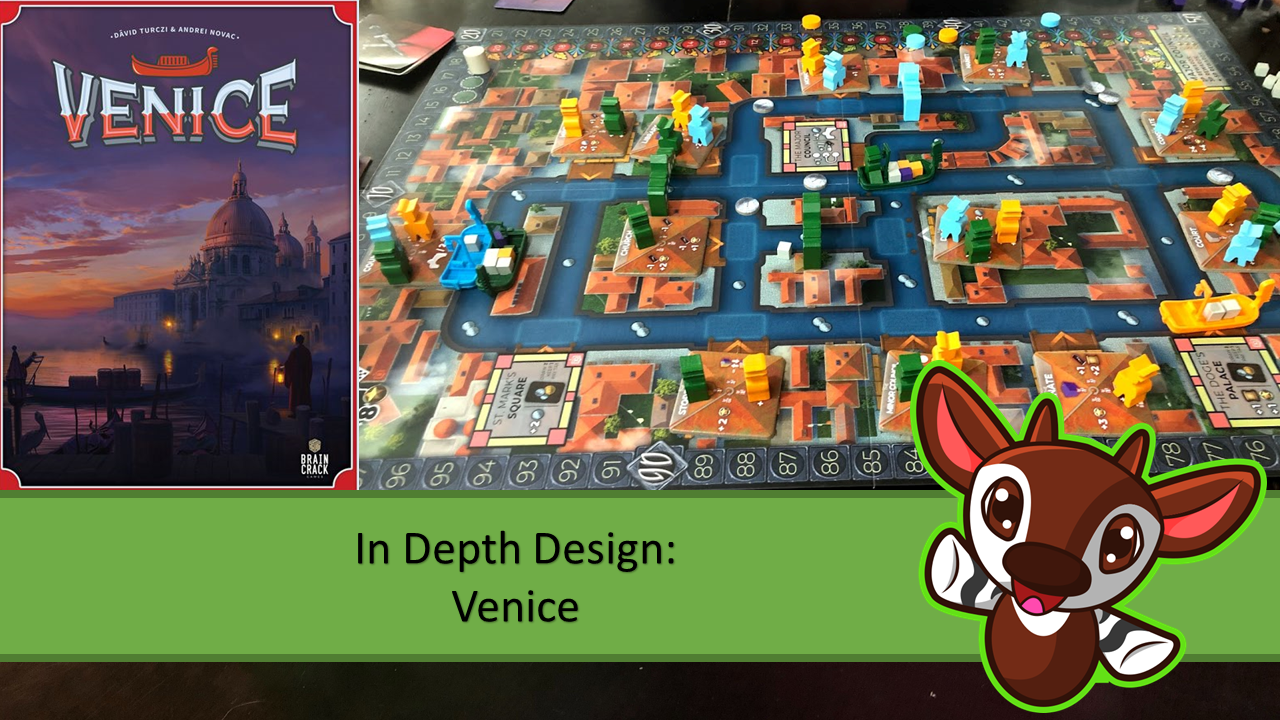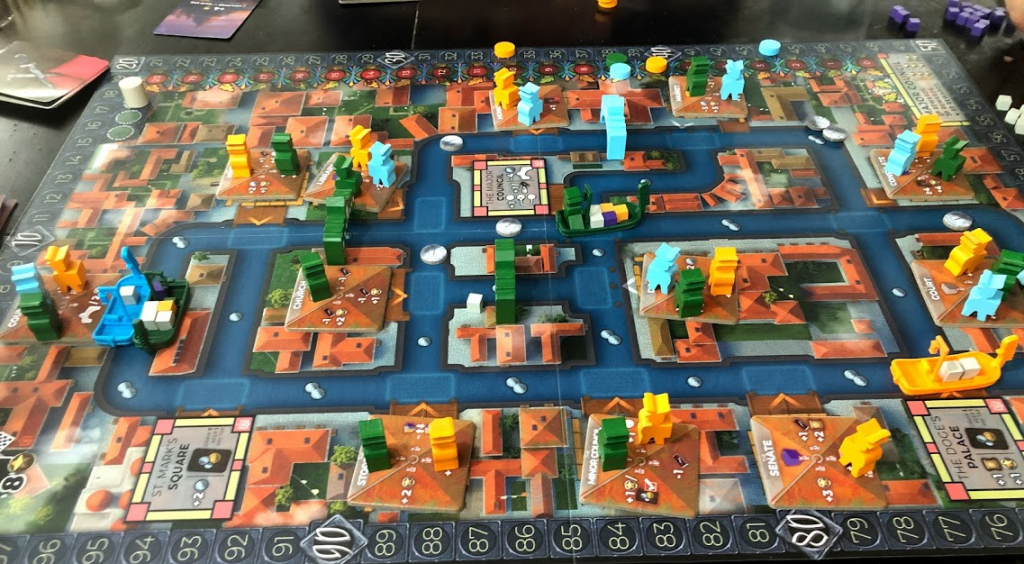
If you haven’t played Venice by Braincrack Games, you can check out the BGG page or this video by Gaming Rules!
Venice is a really neat blend of worker placement and pick up and deliver. In Venice, you’ll travel around Venice in gondolas, leaving assistants at most of the locations you stop on. Each time you stop your movement at a location that has your assistant there, you can upgrade your assistant so you’ll get more choices between rewards you’ll get when you stop at that location or pass it up in the future. The game end is triggered when a certain number of mission cards have been drawn or when a player’s prestige gets high enough, after which two more rounds are played.

First-Time Player Bonus
The first-time player bonus is a really neat thing I haven’t seen before. If it’s your first time playing the game, you’ll get a card you can use to get your choice of money or resources during the game, or extra VP at the end. This is great, especially considering that games like Venice give a definitive advantage to people that have played before. The multiple options on the card mean that if you’re ever stuck, you can use it for what you need most to make up for any missteps while learning the game.

This is something I definitely want to incorporate in any game that takes a bit to learn. Making someone’s first playthrough of a game better means they’re a lot more willing to play again. So, regardless of whether you’re all learning Venice together or you’re the only new player, your experience will hopefully be better because of a single added card!
Intrigue
Each player keeps track of their scrolls and intrigue during the game. Scrolls are used to complete missions, which can give the player points and money during the game, and are also used at the end of the game to lower intrigue. Tracking intrigue is incredibly important; the player with the most at the end of the game instantly loses, regardless of their score!
Numerous games have this sort of mechanic, sure, but it’s an interesting aspect of Venice. Intrigue is usually gained by visiting locations (being able to gain something good, typically allowing the player to gain more points), but there are other ways to gain it as well. Whenever players pass each other they can choose to either lose a scroll or gain a point of intrigue. Also, some locations can give intrigue to other players.
Another particularly unique part of this system is that if you get to a certain amount of intrigue, you start losing points! This means you can win with a low score by forcing your opponents to so much intrigue they either lose the game or lose points. While I don’t typically like negative player interactions, the intrigue track is long enough that players can compensate for other players giving them intrigue.
Assistants
The worker placement aspect of Venice allows players to leave assistants at locations, and the assistants determine what each player will gain from each location.
Furthermore, I really liked that the number of points you gain from the prestige track is based on how many assistants you place. If you put out all (or almost all) of your assistants, you’ll get points equal to your prestige; but if you only put out 7-8 assistants, you’ll only get half that amount. So, do you put out lots of assistants but not upgrade many in an attempt to get more points in the long run, or do you put out fewer assistants and focus on upgrading them so you’ll have more choices and better actions available to you?
It’s definitely an interesting choice, and it’s not straightforward, especially since Venice has a slight engine-building aspect as well. If you have great actions available, you can finish missions quicker and more efficiently, while other players will earn more points for select actions in the long run.
Bumping System
One final aspect that I really appreciated was the bumping system. If you have an assistant at a location and another player adds an assistant there, your assistant can get upgraded. It’s a really simple way to add in positive player interaction and escalate the game. I greatly appreciate both aspects.
Improvements
I really did enjoy Venice, but one aspect I didn’t like was kind of simple: when your assistant is at a location, you typically can’t see what choices are available there. This meant we had to pick up our assistants and peek at actions during gameplay, and even worse, that we had to try to remember what each location did. This wasn’t terrible, but it did add time and cognitive load to the game. If the tiles were just a bit larger or if there was a better spot for the assistants, it would’ve made a big difference.
Did you enjoy this entry? Have you played Venice before? What did you think was the most innovative aspect of the game? Please let me know! I’d love to hear what you think and what kind of things you’d like to see from this blog. Feel free to send me an email or comment with your thoughts!
Don’t forget to sign up for my mailing list, so you don’t miss a post: https://tinyletter.com/carlakopp